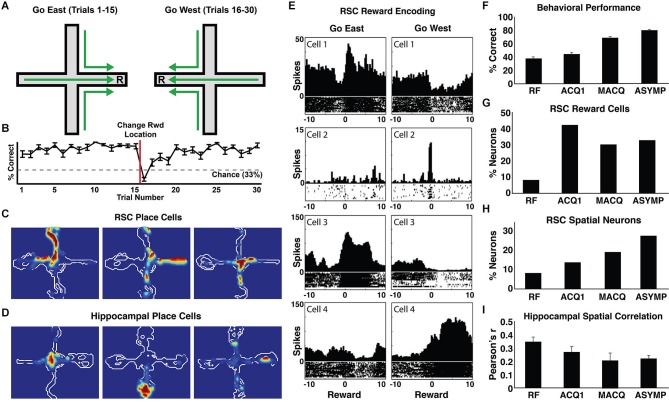Figure 3.
Neural coding by RSC and hippocampal neurons during navigation. (A) A schematic of the blocked alternation task from Smith et al. (2012). Rats navigated to one location for a reward during the first 15 trials of every session (east arm), and navigated to a different location (on the same maze) during the second 15 trials (west arm). (B) Rats used the reward location as a navigation cue. Line graph shows average percent correct on each trial during asymptotic performance of the blocked alternation task. Rats employed a win-stay strategy, returning to the location that was rewarded on the previous trial. After discovering that the reward location had changed on trial 16, the rats began navigating to the new reward location. (C) Examples of RSC place cells and (D) hippocampal place cells. (E) Examples of RSC location-specific reward responses. Each pair of perievent time histograms shows the spiking activity of a single neuron, with the left and right histograms showing firing during the 10 s before and after the go east and go west rewards. RSC neurons occasionally showed punctuate firing at the instant of one reward (cells 1–2). Other RSC neurons showed sustained elevated firing while the rat consumed the reward in one location, and decreased firing during the other reward (cells 3–4). (F) Navigation performance improved with training. The average percentage of trials in which the rats made the correct arm entry is shown for random foraging pretraining (RF), the first training session (ACQ1), the session half way through training (middle acquisition, MACQ), and asymptotic performance (ASYMP). (G) The proportion of RSC neurons that differentially encoded the two reward locations increased dramatically on the first day of training (when the reward locations became useful navigation cues) and then remained high throughout the rest of training. (H) The proportion of RSC neurons with place fields increased steadily with training. (I) Although the proportion of hippocampal neurons with place fields remained the same throughout training (not shown), the activity of these neurons became more distinct in the Go East and Go West conditions as the rats learned the task (average spatial correlations, Pearson’s r). Adapted from Smith et al. (2012).

